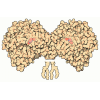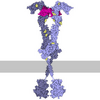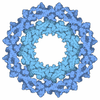[English] 日本語
 Yorodumi
Yorodumi- PDB-9fk5: Zebrafish Betaglycan Orphan Domain (zfBGo) in complex with TGF-B3... -
+ Open data
Open data
- Basic information
Basic information
| Entry | Database: PDB / ID: 9fk5 | |||||||||
|---|---|---|---|---|---|---|---|---|---|---|
| Title | Zebrafish Betaglycan Orphan Domain (zfBGo) in complex with TGF-B3 and extracellular domains of TGFBRI and TGFBRII | |||||||||
 Components Components |
| |||||||||
 Keywords Keywords | MEMBRANE PROTEIN / Complex / Betaglycan / TGFBR3 / TGFb / TGFBR1 / TGFBR2 | |||||||||
| Function / homology |  Function and homology information Function and homology informationFGFR1b ligand binding and activation / FGFR1c ligand binding and activation / TGF-beta receptor signaling activates SMADs / TGFBR3 PTM regulation / TGFBR3 regulates TGF-beta signaling / TGFBR3 regulates FGF2 signaling / positive regulation of tolerance induction to self antigen / positive regulation of B cell tolerance induction / uterine wall breakdown / inferior endocardial cushion morphogenesis ...FGFR1b ligand binding and activation / FGFR1c ligand binding and activation / TGF-beta receptor signaling activates SMADs / TGFBR3 PTM regulation / TGFBR3 regulates TGF-beta signaling / TGFBR3 regulates FGF2 signaling / positive regulation of tolerance induction to self antigen / positive regulation of B cell tolerance induction / uterine wall breakdown / inferior endocardial cushion morphogenesis / transforming growth factor beta receptor activity, type II / bronchus morphogenesis / mammary gland morphogenesis / detection of hypoxia / lens fiber cell apoptotic process / growth plate cartilage chondrocyte growth / extracellular structure organization / epicardium morphogenesis / tricuspid valve morphogenesis / vascular endothelial cell proliferation / TGFBR2 MSI Frameshift Mutants in Cancer / miRNA transport / parathyroid gland development / transforming growth factor beta ligand-receptor complex / regulation of cardiac muscle cell proliferation / type III transforming growth factor beta receptor binding / aorta morphogenesis / myofibroblast differentiation / positive regulation of epithelial to mesenchymal transition involved in endocardial cushion formation / Langerhans cell differentiation / TGFBR2 Kinase Domain Mutants in Cancer / transforming growth factor beta receptor activity / cardiac left ventricle morphogenesis / regulation of transforming growth factor beta receptor signaling pathway / secondary palate development / negative regulation of macrophage cytokine production / trophoblast cell migration / angiogenesis involved in coronary vascular morphogenesis / SMAD2/3 Phosphorylation Motif Mutants in Cancer / TGFBR1 KD Mutants in Cancer / positive regulation of mesenchymal stem cell proliferation / endocardial cushion fusion / ventricular compact myocardium morphogenesis / positive regulation of extracellular matrix assembly / positive regulation of T cell tolerance induction / membranous septum morphogenesis / positive regulation of tight junction disassembly / positive regulation of NK T cell differentiation / cardiac epithelial to mesenchymal transition / mesenchymal cell differentiation / somite development / TGFBR3 regulates TGF-beta signaling / transforming growth factor beta receptor activity, type I / positive regulation of vasculature development / neuron fate commitment / activin receptor complex / activin receptor activity, type I / regulation of epithelial to mesenchymal transition / lung lobe morphogenesis / type II transforming growth factor beta receptor binding / pharyngeal system development / transmembrane receptor protein serine/threonine kinase activity / receptor protein serine/threonine kinase / regulation of stem cell proliferation / activin binding / TGFBR1 LBD Mutants in Cancer / SMAD protein signal transduction / type I transforming growth factor beta receptor binding / germ cell migration / myeloid dendritic cell differentiation / filopodium assembly / coronary artery morphogenesis / embryonic cranial skeleton morphogenesis / glycosaminoglycan binding / activin receptor signaling pathway / ventricular trabecula myocardium morphogenesis / positive regulation of CD4-positive, alpha-beta T cell proliferation / regulation of stem cell differentiation / response to cholesterol / mammary gland development / outflow tract septum morphogenesis / cell-cell junction organization / I-SMAD binding / transforming growth factor beta binding / sprouting angiogenesis / collagen fibril organization / negative regulation of chondrocyte differentiation / kinase activator activity / lens development in camera-type eye / aortic valve morphogenesis / atrioventricular valve morphogenesis / face morphogenesis / endothelial cell activation / odontogenesis / anterior/posterior pattern specification / positive regulation of mesenchymal cell proliferation / positive regulation of filopodium assembly / artery morphogenesis / embryonic hemopoiesis / Molecules associated with elastic fibres Similarity search - Function | |||||||||
| Biological species |  Homo sapiens (human) Homo sapiens (human) | |||||||||
| Method | ELECTRON MICROSCOPY / single particle reconstruction / cryo EM / Resolution: 4.1 Å | |||||||||
 Authors Authors | Wieteska, L. / Coleman, J.A. / Hinck, A.P. | |||||||||
| Funding support |  United States, European Union, 2items United States, European Union, 2items
| |||||||||
 Citation Citation |  Journal: Nat Commun / Year: 2025 Journal: Nat Commun / Year: 2025Title: Structures of TGF-β with betaglycan and signaling receptors reveal mechanisms of complex assembly and signaling. Authors: Łukasz Wieteska / Alexander B Taylor / Emma Punch / Jonathan A Coleman / Isabella O Conway / Yeu-Farn Lin / Chang-Hyeock Byeon / Cynthia S Hinck / Troy Krzysiak / Rieko Ishima / Fernando ...Authors: Łukasz Wieteska / Alexander B Taylor / Emma Punch / Jonathan A Coleman / Isabella O Conway / Yeu-Farn Lin / Chang-Hyeock Byeon / Cynthia S Hinck / Troy Krzysiak / Rieko Ishima / Fernando López-Casillas / Peter Cherepanov / Daniel J Bernard / Caroline S Hill / Andrew P Hinck /     Abstract: Betaglycan (BG) is a transmembrane co-receptor of the transforming growth factor-β (TGF-β) family of signaling ligands. It is essential for embryonic development, tissue homeostasis and fertility ...Betaglycan (BG) is a transmembrane co-receptor of the transforming growth factor-β (TGF-β) family of signaling ligands. It is essential for embryonic development, tissue homeostasis and fertility in adults. It functions by enabling binding of the three TGF-β isoforms to their signaling receptors and is additionally required for inhibin A (InhA) activity. Despite its requirement for the functions of TGF-βs and InhA in vivo, structural information explaining BG ligand selectivity and its mechanism of action is lacking. Here, we determine the structure of TGF-β bound both to BG and the signaling receptors, TGFBR1 and TGFBR2. We identify key regions responsible for ligand engagement, which has revealed binding interfaces that differ from those described for the closely related co-receptor of the TGF-β family, endoglin, thus demonstrating remarkable evolutionary adaptation to enable ligand selectivity. Finally, we provide a structural explanation for the hand-off mechanism underlying TGF-β signal potentiation. | |||||||||
| History |
|
- Structure visualization
Structure visualization
| Structure viewer | Molecule:  Molmil Molmil Jmol/JSmol Jmol/JSmol |
|---|
- Downloads & links
Downloads & links
- Download
Download
| PDBx/mmCIF format |  9fk5.cif.gz 9fk5.cif.gz | 141.3 KB | Display |  PDBx/mmCIF format PDBx/mmCIF format |
|---|---|---|---|---|
| PDB format |  pdb9fk5.ent.gz pdb9fk5.ent.gz | 108 KB | Display |  PDB format PDB format |
| PDBx/mmJSON format |  9fk5.json.gz 9fk5.json.gz | Tree view |  PDBx/mmJSON format PDBx/mmJSON format | |
| Others |  Other downloads Other downloads |
-Validation report
| Summary document |  9fk5_validation.pdf.gz 9fk5_validation.pdf.gz | 1.1 MB | Display |  wwPDB validaton report wwPDB validaton report |
|---|---|---|---|---|
| Full document |  9fk5_full_validation.pdf.gz 9fk5_full_validation.pdf.gz | 1.1 MB | Display | |
| Data in XML |  9fk5_validation.xml.gz 9fk5_validation.xml.gz | 41 KB | Display | |
| Data in CIF |  9fk5_validation.cif.gz 9fk5_validation.cif.gz | 59.3 KB | Display | |
| Arichive directory |  https://data.pdbj.org/pub/pdb/validation_reports/fk/9fk5 https://data.pdbj.org/pub/pdb/validation_reports/fk/9fk5 ftp://data.pdbj.org/pub/pdb/validation_reports/fk/9fk5 ftp://data.pdbj.org/pub/pdb/validation_reports/fk/9fk5 | HTTPS FTP |
-Related structure data
| Related structure data | 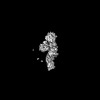 50519MC  8dc0C 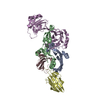 9b9fC  9fdyC 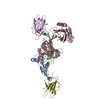 9fkpC C: citing same article ( M: map data used to model this data |
|---|---|
| Similar structure data | Similarity search - Function & homology  F&H Search F&H Search |
- Links
Links
- Assembly
Assembly
| Deposited unit | 
|
|---|---|
| 1 |
|
- Components
Components
| #1: Protein | Mass: 12734.504 Da / Num. of mol.: 1 Source method: isolated from a genetically manipulated source Source: (gene. exp.)  Homo sapiens (human) / Gene: TGFB3 / Production host: Homo sapiens (human) / Gene: TGFB3 / Production host:  |
|---|---|
| #2: Protein | Mass: 12586.247 Da / Num. of mol.: 1 / Mutation: R325E,Y390A,R394E Source method: isolated from a genetically manipulated source Source: (gene. exp.)  Homo sapiens (human) / Gene: TGFB3 / Production host: Homo sapiens (human) / Gene: TGFB3 / Production host:  |
| #3: Protein | Mass: 9474.826 Da / Num. of mol.: 1 Source method: isolated from a genetically manipulated source Source: (gene. exp.)  Homo sapiens (human) / Gene: TGFBR1, ALK5, SKR4 / Production host: Homo sapiens (human) / Gene: TGFBR1, ALK5, SKR4 / Production host:  References: UniProt: P36897, receptor protein serine/threonine kinase |
| #4: Protein | Mass: 12926.812 Da / Num. of mol.: 1 Source method: isolated from a genetically manipulated source Source: (gene. exp.)  Homo sapiens (human) / Gene: TGFBR2 / Production host: Homo sapiens (human) / Gene: TGFBR2 / Production host:  References: UniProt: P37173, receptor protein serine/threonine kinase |
| #5: Protein | Mass: 37727.000 Da / Num. of mol.: 1 / Mutation: C150G,C277G Source method: isolated from a genetically manipulated source Source: (gene. exp.)   Homo sapiens (human) / References: UniProt: A0A0H3UK16 Homo sapiens (human) / References: UniProt: A0A0H3UK16 |
| Has protein modification | Y |
-Experimental details
-Experiment
| Experiment | Method: ELECTRON MICROSCOPY |
|---|---|
| EM experiment | Aggregation state: PARTICLE / 3D reconstruction method: single particle reconstruction |
- Sample preparation
Sample preparation
| Component |
| ||||||||||||||||||||||||
|---|---|---|---|---|---|---|---|---|---|---|---|---|---|---|---|---|---|---|---|---|---|---|---|---|---|
| Molecular weight |
| ||||||||||||||||||||||||
| Source (natural) |
| ||||||||||||||||||||||||
| Source (recombinant) |
| ||||||||||||||||||||||||
| Buffer solution | pH: 7.4 | ||||||||||||||||||||||||
| Buffer component |
| ||||||||||||||||||||||||
| Specimen | Conc.: 0.3 mg/ml / Embedding applied: NO / Shadowing applied: NO / Staining applied: NO / Vitrification applied: YES | ||||||||||||||||||||||||
| Specimen support | Grid material: GOLD / Grid mesh size: 300 divisions/in. / Grid type: UltrAuFoil R1.2/1.3 | ||||||||||||||||||||||||
| Vitrification | Instrument: FEI VITROBOT MARK IV / Cryogen name: ETHANE / Humidity: 100 % / Chamber temperature: 298 K |
- Electron microscopy imaging
Electron microscopy imaging
| Experimental equipment |  Model: Titan Krios / Image courtesy: FEI Company |
|---|---|
| Microscopy | Model: TFS KRIOS |
| Electron gun | Electron source:  FIELD EMISSION GUN / Accelerating voltage: 300 kV / Illumination mode: FLOOD BEAM FIELD EMISSION GUN / Accelerating voltage: 300 kV / Illumination mode: FLOOD BEAM |
| Electron lens | Mode: BRIGHT FIELD / Nominal defocus max: 2500 nm / Nominal defocus min: 750 nm / Alignment procedure: COMA FREE |
| Image recording | Electron dose: 45 e/Å2 / Film or detector model: FEI FALCON IV (4k x 4k) |
- Processing
Processing
| EM software |
| ||||||||||||||||||||||||||||
|---|---|---|---|---|---|---|---|---|---|---|---|---|---|---|---|---|---|---|---|---|---|---|---|---|---|---|---|---|---|
| CTF correction | Type: PHASE FLIPPING AND AMPLITUDE CORRECTION | ||||||||||||||||||||||||||||
| 3D reconstruction | Resolution: 4.1 Å / Resolution method: FSC 0.5 CUT-OFF / Num. of particles: 281881 / Symmetry type: POINT | ||||||||||||||||||||||||||||
| Atomic model building | Protocol: FLEXIBLE FIT / Space: REAL | ||||||||||||||||||||||||||||
| Atomic model building | PDB-ID: 9B9F Accession code: 9B9F / Source name: PDB / Type: experimental model |
 Movie
Movie Controller
Controller


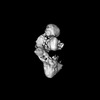


 PDBj
PDBj